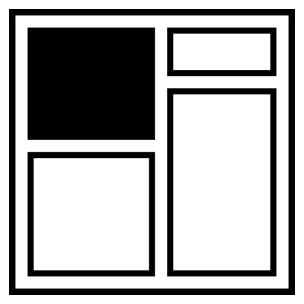Jank-Free Image Loads
There are a few fundamental problems with embedding images in pages of hypertext; perhaps chief among them is this: text is very light and loads rather fast; images are much heavier and arrive much later. Consequently, millions (billions?) of times a day, a hapless Web surfer will start reading some text on a page, and then —
— oops! — an image pops in above it, pushing said text down the page, and our poor reader loses their place.
By default, partially-loaded pages have the user experience of a slippery fish, or spilled jar of jumping beans. For the rest of this article, I shall call that jarring, no-good jumpiness by its name: jank. And I’ll chart a path into a jank-free future – one in which it’s easy and natural to author <img> elements that load like this:
Jank is a very old problem, and there is a very old solution to it: the width and height attributes on <img>. The idea is: if we stick an image’s dimensions right into the HTML, browsers can know those dimensions before the image loads, and reserve some space on the layout for it so that nothing gets bumped down the page when the image finally arrives.
widthSpecifies the intended width of the image in pixels. When given together with the
height, this allows user agents to reserve screen space for the image before the image data has arrived over the network.
—The HTML 3.2 Specification, published on January 14 1997
Unfortunately for us, when width and height were first spec’d and implemented, layouts were largely fixed and images were usually only intended to render at their fixed, actual dimensions. When image sizing gets fluid, width and height get weird:
See the Pen fluid width + fixed height = distortion by Eric Portis (@eeeps) on CodePen.
width and height are too rigid for the responsive world. What we need, and have needed for a very long time, is a way to specify fixed aspect ratios, to pair with our fluid widths.
I have good news, bad news, and great news.
The good news is, there are ways to do this, now, that work in every browser. Responsible sites, and responsible developers, go through the effort to do them.
The bad news is that these techniques are all terrible, cumbersome hacks. They’re difficult to remember, difficult to understand, and they can interact with other pieces of CSS in unexpected ways.
So, the great news: there are two on-the-horizon web platform features that are trying to make no-jank, fixed-aspect-ratio, fluid-width images a natural part of the web platform.
aspect-ratio in CSS
The first proposed feature? An aspect-ratio property in CSS!
This would allow us to write CSS like this:
img {
width: 100%;
}
.thumb {
aspect-ratio: 1/1;
}
.hero {
aspect-ratio: 16/9;
}This’ll work wonders when we need to set aspect ratios for whole classes of images, which are all sized to fit within pre-defined layout slots, like the .thumb and .hero images, above.
Alas, the harder problem, in my experience, is not images with known-ahead-of-time aspect ratios. It’s images – possibly user generated images – that can have any aspect ratio. The really tricky problem is unknown-when-you’re-writing-your-CSS aspect ratios that can vary per-image. Using aspect-ratio to reserve space for images like this requires inline styles:
<img src="image.jpg" style="aspect-ratio: 5/4" />And inline styles give me the heebie-jeebies! As a web developer of a certain age, I have a tiny man in a blue beanie permanently embedded deep within my hindbrain, who cries out in agony whenever I author a style="" attribute. And you know what? The old man has a point! By sticking super-high-specificity inline styles in my content, I’m cutting off my, (or anyone else’s) ability to change those aspect ratios, for whatever reason, later.
How might we specify aspect ratios at a lower level? How might we give browsers information about an image’s dimensions, without giving them explicit instructions about how to style it?
I’ll tell you: we could give browsers the intrinsic aspect ratio of the image in our HTML, rather than specifying an extrinsic aspect ratio!
A brief note on intrinsic and extrinsic sizing
What do I mean by “intrinsic” and “extrinsic?”
The intrinsic size of an image is, put simply, how big it’d be if you plopped it onto a page and applied no CSS to it whatsoever. An 800×600 image has an intrinsic width of 800px.
The extrinsic size of an image, then, is how large it ends up after CSS has been applied. Stick a width: 300px rule on that same 800×600 image, and its intrinsic size (accessible via the Image.naturalWidth property, in JavaScript) doesn’t change: its intrinsic size is still 800px. But this image now has an extrinsic size (accessible via Image.clientWidth) of 300px.
It surprised me to learn this year that height and width are interpreted as presentational hints and that they end up setting extrinsic dimensions (albeit ones that, unlike inline styles, have absolutely no specificity).
CSS aspect-ratio lets us avoid setting extrinsic heights and widths – and instead lets us give images (or anything else) an extrinsic aspect ratio, so that as soon as we set one dimension (possibly to a fluid width, like 100%!), the other dimension is set automatically in relation to it.
The last tool I’m going to talk about gets us out of the extrinsic sizing game all together — which, I think, is only appropriate for a feature that we’re going to be using in HTML.
intrinsicsize in HTML
The proposed intrinsicsize attribute will let you do this:
<img src="image.jpg" intrinsicsize="800x600" />That tells the browser, “hey, this image.jpg that I’m using here – I know you haven’t loaded it yet but I’m just going to let you know right away that it’s going to have an intrinsic size of 800×600.” This gives the browser enough information to reserve space on the layout for the image, and ensures that any and all extrinsic sizing instructions, specified in our CSS, will layer cleanly on top of this, the image’s intrinsic size.
You may ask (I did!): wait, what if my <img> references multiple resources, which all have different intrinsic sizes? Well, if you’re using srcset, intrinsicsize is a bit of a misnomer – what the attribute will do then, is specify an intrinsic aspect ratio:
<img
srcset="300x200.jpg 300w,
600x400.jpg 600w,
900x600.jpg 900w,
1200x800.jpg 1200w"
sizes="75vw"
intrinsicsize="3x2" />In the future (and behind the “Experimental Web Platform Features” flag right now, in Chrome 71+), asking this image for its .naturalWidth would not return 3 – it will return whatever 75vw is, given the current viewport width. And Image.naturalHeight will return that width, divided by the intrinsic aspect ratio: 3/2.
Can’t wait
I seem to have gotten myself into the weeds a bit. Sizing on the web is complicated!
Don’t let all of these details bury the big takeaway here: sometime soon (🤞 2019‽ 🤞), we’ll be able to toss our terrible aspect-ratio hacks into the dustbin of history, get in the habit of setting aspect-ratios in CSS and/or intrinsicsizes in HTML, and surf a less-frustrating, more-performant, less-janky web. I can’t wait!
About the author
Eric lives and works on Orcas Island, off the coast of Washington State. He used to work on fine art for a living and do web standards as a hobby; in 2016 he flipped that script and now works as a Web Platform Advocate at Cloudinary.







